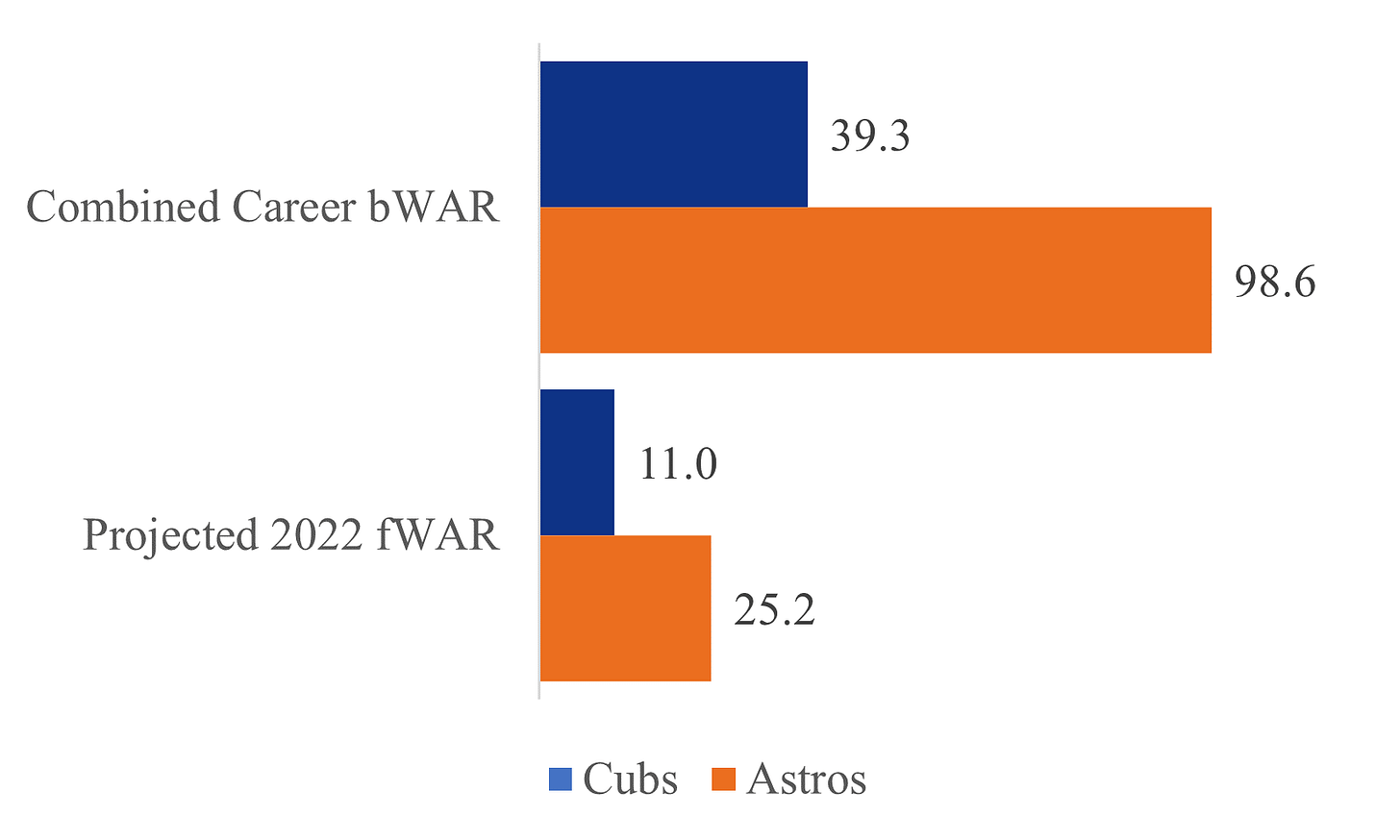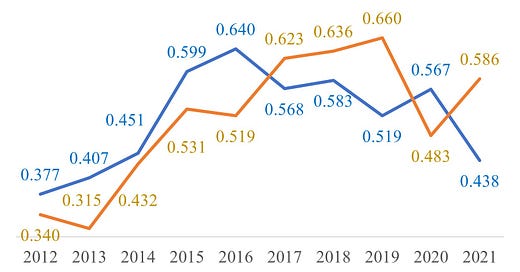The Astros and Cubs Were Once on the Same Path; Now It Is Diverging
Or Why Developing Young Players Is the Key to Long Term Baseball Success.
In 2012, the Astros and Cubs were in the same place—at the bottom the MLB standings. The Astros had the worst record in MLB and the Cubs were not far behind. But led by young infields and more veteran rotations, both teams rose together, and each earned their first playoff appearance with this core in 2015. The rise continued and the Cubs won the World Series in 2016 and the Astros in 2017. And the two teams continued to make playoff appearances throughout the rest of the decade.
You can see the similarly of the records of the two franchises on the chart above. And then came 2021, and the two teams diverged significantly. The Astros won 95 games, the AL West title, and the American League pennant. The Cubs won only 71 games, and traded away the core of that 2016 World Champion—Kris Bryant, Anthony Rizzo, and Javy Baez—at the trade deadline.
Looking ahead to 2022, the Depth Charts projections shows the current Astros roster is projected for 45.4 fWAR, the fifth most in the majors. The Cubs are projected with 28.9 WAR. They are the mirror image of the Astros—that’s fifth worst in the majors.
How did these franchises whose records and narratives converged throughout the 2010s diverge so much in the early 2020s? The answer is simple. The Astros have developed a number of regulars since this core first reached the playoffs in the 2015, including some of the roster’s biggest stars. And since their core first reached the playoffs in 2015, the Cubs have developed few everyday players, and those that they have developed have tended to be pretty average.
The Astros and Cubs both ascended to the top of the baseball world because of fabulous player development systems. Both teams had star infields in the World Championship years, centered on players the teams had acquired in the draft (Kris Bryant and Alex Bregman were both #2 overall picks; Carlos Correa and Javy Baez were both early first round Puerto Rican shortstops). The Astros had big success with international signings (Jose Altuve, Yuli Gurriel), while the Cubs traded for prospects who developed into stars (Anthony Rizzo, Addison Russell).
But the development systems started to diverge after 2016. That season, the Cubs brought up Willson Contreras, the last piece to their World Series winning team. The Astros debuted Yuli Gurriel and Alex Bregman, both of whom would star in the next season’s World Series.
But the Cubs stopped developed All Star players after Contreras. Since 2017, the best player that debuted with the Cubs—Ian Happ—has earned 6.5 bWAR since his debut. In that time, the Astros have debuted nearly a complete pitching rotation (Framber Valdez, Jose Urquidy, Luis Garcia & Cristian Javier) and three of their nine starters from Game 1 of the 2021 World Series (Yordan Alvarez, Kyle Tucker, and Chas McCormick).
The chart below shows two measures for each franchise based on the players who have debuted for the Astros and Cubs since the 2016 season. The first is the combined bWAR for all players who have debuted for each franchise. You can see that the players the Astros have developed have produced 251% more WAR than the Cubs.

But the combined career WAR measure has some flaws. For example, it includes players who debuted with each team who were then traded elsewhere (e.g. Jeimer Candelario, Joe Musgrove, and Teoscar Hernandez). And the combined WAR measure enhances the contributions of those who debuted early (e.g Contreras and Bregman) over those who debuted more recently. So I took a look at the Depth Charts at Fangraphs for 2022 fWAR projections for those on the two teams’ current rosters.
The players the Astros have developed recently are projected to add 25.2 wins to the Astros total this season. Alex Bregman is projected to earn 5.0 fWAR in 2022, the highest on the Astros. The Cubs are projected to get only 11.0 wins from their recent debutants. And the Cubs best player entering 2022 is also a recent debutante, but Ian Happ is expected to contribute a more pedestrian 2.6 fWAR next season.
Why Young Players Are So Valuable
The structure of baseball’s financial system makes is imperative that team’s develop young players. Players do not gain the full ability to negotiate a market wage until after they have accrued six years of service time. Before that, teams set a player’s salary for the first three years of their career, and then go through arbitration for years four through six.
As a result, teams can pay players a fraction of their value. In 2021, Kyle Tucker, who debuted in 2018, accrued 4.8 fWAR for the Astros, which was 23rd best among major league hitters. Fangraphs estimates the “value” of his play at $38.2 million. The Astros paid him $624,300 for his services.
Compare that to Michael Brantley, who was worth 2.1 fWAR for the Astros in 2021. He produced $16.9 million in value, right near his 2021 salary of $16 million. Once a player gets to free agency, they are paid something close to what they are worth, and that makes it difficult for teams to pay enough to win enough games to make the playoffs and keep their owners profit margins as high as they wish.
The Cubs faced this situation in the 2021 season. Their infield stars who brought them to the 2016 title were about to enter free agency. The Cubs could sign them all to fair value contracts. But without a new young core of players who could create more value than their salary, the Cubs did not think they could compete in the near future. Instead, they traded Rizzo, Baez, Bryant, and closer Craig Kimbrell for prospects, and have started another rebuild.
The Astros are in a very different situation now than the Cubs thanks to the development of their new young core. Players like Tucker, Alvarez, Valdez, and Garcia all starred on the 2021 version and will do so again in 2022, all while making salaries near the league minimum. Thanks to development of these players, the Astros have been able to supplement their core from their championship team and extend their championship window into a new decade. The Astros enter 2022 as the favorites in the American League West again. And with rosters frozen with the lockout, they stand with the fifth highest projected combined fWAR for the 2022 season.
Of course, the pressure to develop young players never stops for baseball teams. The current young core will get more expensive in future years as they enter the salary arbitration process, and free agency looms on the horizon. To continue to contend in the middle of this decade, they need to continue to debut new players who can contribute to the team and keep the payroll at the level preferred by Jim Crane.
So prospects like Jeremy Pena, Korey Lee, and Hunter Brown are important figures for the Astros in the near future. It is likely that Carlos Correa will sign with another franchise after the lockout, and either in Spring Training or sometime over the next season, Pena will take over at shortstop. Developing Pena into an effective major leaguer is vital to the long term hopes of the franchise. Lee plays a similar role at catcher, though he likely won’t take over the full time job until the 2023 season. And Brown could join the rotation in 2023 as well.




